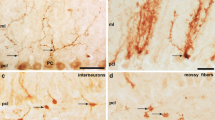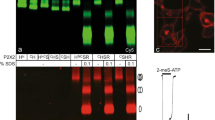Abstract.
The green fluorescent protein (GFP) has become a powerful tool in molecular and cell biology. It is a commonly used marker for cloning and transfection experiments as well as a useful label of living cells allowing continuous observation of developing structures. In order to unravel mechanisms of neuronal differentiation, we generated a transgenic mouse model which expresses GFPS65T,hu under the control of the Purkinje cell-specific promoter L7/pcp-2. Here, we show that GFPS65T,hu is highly expressed specifically in the cerebellum in whole mount preparations after the 2nd postnatal week. GFPS65T,hu can be detected exclusively in Purkinje cells of cerebellar slices. The fluorescence intensity of GFPS65T,hu should enable the characterization and recording of axons, dendrites, and spines protruding from these neuronal processes. The level of GFP expression can be quantified by western blotting which allows to analyze protein expression and L7/pcp-2 promoter regulation in vivo. The application of cellular and physiological techniques on L7GFP mice will provide a remarkable opportunity to investigate various aspects of neuronal development at the cellular and subcellular levels.
Similar content being viewed by others
Author information
Authors and Affiliations
Additional information
Electronic Publication
Rights and permissions
About this article
Cite this article
Zhang, X., Baader, S.L., Bian, F. et al. High level Purkinje cell specific expression of green fluorescent protein in transgenic mice. Histochem Cell Biol 115, 455–464 (2001). https://doi.org/10.1007/s004180100283
Accepted:
Issue Date:
DOI: https://doi.org/10.1007/s004180100283




